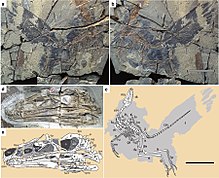Caihong
| Caihong Temporal range: Late Jurassic,
| |
|---|---|

| |
| The holotype of Caihong juji, PMoL-B00175 | |
| Scientific classification | |
| Domain: | Eukaryota |
| Kingdom: | Animalia |
| Phylum: | Chordata |
| Clade: | Dinosauria |
| Clade: | Saurischia |
| Clade: | Theropoda |
| Family: | †Anchiornithidae |
| Genus: | †Caihong Hu et al., 2018 |
| Type species | |
| †Caihong juji Hu et al., 2018
| |
Caihong (Chinese: 彩虹; pinyin: cǎihóng; literally: "rainbow") is an extinct dinobird from Late Jurassic China. Caihong was discovered in 2014. The animal may predate the famous Aurornis xui, the earliest bird, by about 1 million years.[1]
The type species, Caihong juji, was named in 2018.
Description
[change | change source]Size
[change | change source]
Caihong was a rather small dinosaur. Its length was estimated at 40 cm (16 inches), and its weight at 475 g (1.047 pounds).
Skeleton
[change | change source]
The skull of Caihong has a length of 67.6 millimetres. It is low and elongated (superficially similar to that of Velociraptor), only slightly shorter than the femur.
Vertebrae
[change | change source]Caihong probably has ten neck vertebrae, thirteen back vertebrae, five sacral vertebrae and twenty-sic tail vertebrae.
Feathering and coloration
[change | change source]The fossilized feathers of Caihong showed similarity to a black iridescent color in extant birds. Other feathers found on the head, chest, and the base of the tail preserve flattened sheets of platelet-like melanosomes.
Caihong represents the oldest known evidence of platelet-like melanosomes.
References
[change | change source]- ↑ Dongyu Hu; Julia A. Clarke; Chad M. Eliason; Rui Qiu; Quanguo Li; Matthew D. Shawkey; Cuilin Zhao; Liliana D’Alba; Jinkai Jiang; Xing Xu (2018). "A bony-crested Jurassic dinosaur with evidence of iridescent plumage highlights complexity in early paravian evolution". Nature Communications. 9: Article number 217.
